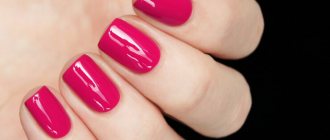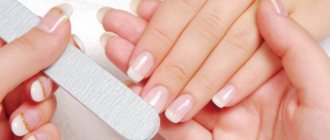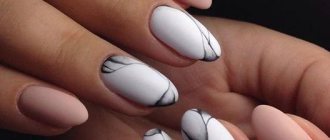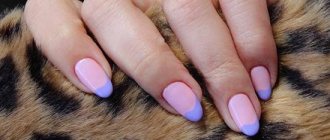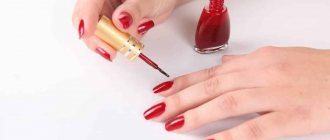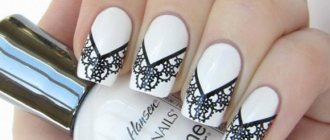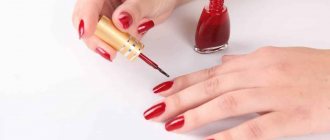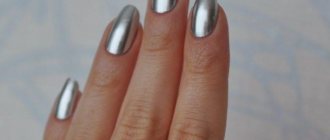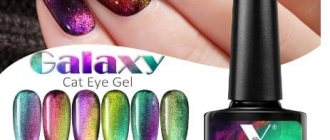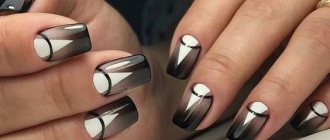Proper manicure at home
As a result, you have to puzzle over how to properly do a manicure using the simplest means at hand right in a hotel, rented apartment or in a sanatorium on the shore of a warm sea.
With such a development of events, detailed instructions will definitely help out, explaining what actions need to be taken in order to apply the right manicure at home in the shortest possible time.
- Strange as it may sound in the era of the widespread dominance of fashionable nail art salons, a completely decent and even stylish manicure can be done even with the most modest budget for cosmetics and with almost a complete lack of relevant skills.
- To be convinced of this, just look at a few photos of a proper manicure on the Internet and in fashion magazines.
Manicure stamping
A slightly more complex technique for applying designs to nails than stickers, but much easier than drawing patterns by hand. Special stencils are used here, through which you can apply beautiful curls, intricate patterns, complex openwork and more to your nails.
Hygienic manicure techniques
Regardless of what plan was adopted for decorating nails - applying varnish, gel or enamel - the procedure for care and decoration should still begin with a hygienic manicure.
Without being able to apply the correct hardware manicure, at home or while traveling, it makes sense to use one of the following two methods:
- Trimming, in which the cuticle and side ridges are processed with special scissors or nippers;
- European, which aims to soften the cuticle and move it towards the nail base.
How and where to learn manicure?
Have you read our article and thought that you would like to become a professional manicurist? A manicurist is not only an interesting and creative profession, but also a good income. However, the choice of teacher and school should be treated with attention and caution.
6 tips on how to choose the right manicure courses or manicure school
Study the program of your training in manicure courses and relate them to the goals of your training so as not to waste time
If you are going to learn how to paint your own nails beautifully and competently and not spend a lot of money on visiting salons, then a short basic manicure course will be enough for you .
If you are seriously planning to do manicure at a professional level, then it is better to look for a basic manicure course, which includes not only the basics, but also all sorts of popular techniques for painting nails and creating various nail designs.
In addition, you will probably also need pedicure skills - it is better to look for courses in which these programs are combined into one course.
The insidiousness and unpredictability of the cuticle
In this case, it is advisable to take wise advice: it is better not to undertake a trimmed manicure if you do not have the slightest idea about the structure of the cuticle and the safe method of processing it.
Simply removing the cuticle is completely unacceptable. This action is strongly opposed by the following two considerations.
- After a few days, burrs will form at the site of the crooked cut and pain will appear.
- This fact will be all the more unpleasant because on the evening of applying the manicure you will get the impression that all the procedures were done flawlessly.
- On each finger, the cuticle has a special structure and is differently close to the capillaries.
- This means that if the skin on one finger can be cut off without pain and suffering, then on the other there will be a very real danger of injuring oneself.
The area where the finger is injured will ache and ache, and if things go badly, it will fester, which will require immediate surgical intervention to completely remove the pus.
How to properly sterilize instruments?
We learned how to properly sterilize instruments from an experienced manicurist, Maria Kaverzneva.
Unfortunately, not all clients know that instruments must go through several stages of disinfection and sterilization. The most important thing is a clean instrument.
Clean does not mean washed in soapy water or a disinfectant solution; clean means sterile. And sterilization is the complete destruction of microorganisms, which occurs under the influence of heat at 180 degrees and above.
Dry and wet manicure
To avoid such a development of events, you need to give yourself a proper manicure with European-style gel polish. It virtually eliminates the risk of injury.
European manicure is divided into dry and wet. Dry is applied using special cuticle treatment products called removers. The second is done using a bath that softens the tissue.
To make a dry manicure, just cover the cuticle with a special product. All that remains is to wait for the time specified by the manufacturer, and then move the cuticle with a special orange stick. Any doubts that this will not be difficult to do will be dispelled after watching a video of a proper manicure.
Stylish monochrome
A great choice for every day, without a fancy print or complex decoration. You simply choose your favorite polish and carefully paint each nail. But you should know that the hardest varnish to apply is white. Therefore, you should be very careful with him.
Required set of accessories
A wet, unedged manicure should be given a little more attention.
To apply it you will need:
- A container with warm water. When traveling, you can use a tea mug or basin. It is desirable that the water temperature be in the range from 37 to 40 degrees;
- Orange stick. You should keep two or three of these sticks ready. The fact is that warm water will quickly destroy the integrity of the stick;
- A file for giving the nail plate a suitable configuration. For natural nails, use a 220 grit file;
You should also keep two towels ready to quickly dry the skin on your hands.
How to do a hardware manicure?
You can also prepare your nails for applying varnish using a special machine. This type of manicure is called hardware manicure. There is nothing complicated about it, but it looks neater and is much faster.
What are cutters for hardware manicure?
The peculiarity of hardware manicure is that many cutter attachments are used, each of which performs its own functions when processing the cuticle of the fingers during a manicure. Mills are attachments for a manicure machine.
How to choose cutters depending on the material:
- Diamond cutters are not only the most expensive and hardest, but also the most effective. They work best with delicate skin.
- Ceramic cutters are the most common type. Such cutters are used by both experienced craftsmen and beginners.
- Metal cutters are a tool for professionals. You need to work with them carefully.
- Silicon carbide cutters are the best option for beginners. They are the cheapest and are considered disposable.
Milling cutters made from different materials are used in the same way, but the harder the material, the more difficult it is to work with. An experienced craftsman can handle cutters made of different materials equally well and work even with the most delicate skin.
What shapes of cutters will be useful for a novice craftsman:
- Cone-shaped cutters are needed for grinding and polishing the side ridges of the nail.
- A ball-shaped bur is necessary for removing irregularities and cracks.
- Cylindrical cutters are used to create nail shapes and remove gel polish.
- Bullet polishers are made from soft materials such as silicone or plastic and are used for finishing and polishing.
Recommendations for working with the manicure device:
- Only dry cuticles should be treated with the device, otherwise they will heat up and you risk damaging them.
- Do not press the device too hard against your nail, otherwise you may damage the structure of the nail plate.
- First, practice using silicone tips. This will help you master the machine and learn how to operate it.
Ready? You can start creating the perfect manicure!
How to do a hardware manicure - step-by-step instructions:
- Remove the cuticle on the side edges of the nail using a needle-shaped (cone-shaped) cutter. The rotation speed of the cutter should be about 1200 rpm.
- Using the same cutter, we carefully lift the cuticle, running the device along the lower edge of the nail. Be careful, delicate thin skin is very easy to hurt!
- Using a truncated cone cutter running at 1000 rpm, remove cuticles from the nail.
- Using a bullet polisher, gently buff the cuticles.
- If the skin around the nail also requires treatment, use a ball-shaped cutter and go over all the bumps and cracks in the skin around the nail plate.
- To give the nail the desired shape, go along the edge of the nail with a cylindrical cutter.
- Your nails are perfect - apply gel polish!
Simple sequence of actions
- First you need to create the desired configuration with a file. It is important to do this just before the bath, otherwise you will have to deal with softened nails that are practically impossible to file.
- The geometry of the nail is selected according to its thickness and length. If you don't have enough time, just shorten the nail slightly. This also makes sense if it still retains the contours obtained in the nail salon.
- Next, you need to soberly assess the condition of the side rollers. If their coarsening is detected, you need to carefully process them with a 180 grit file. It is important that during the work it does not touch the nail in any way.
- Then you need to soak your fingers in the bath for seven to ten minutes. This will significantly soften the cuticle, which will make it much easier to move.
- Then an orange stick is taken and the cuticle is gradually shifted towards the nail base. You should not put too much pressure on the stick, otherwise it will injure both the nail and the cuticle. This algorithm should be reproduced on all other fingers.
- All that remains is to thoroughly wipe your hands with towels.
How to choose a machine for hardware manicure?
We figured out how to do a hardware manicure. But how to choose the right manicure machine? There is nothing complicated about this either, the main thing is to understand why you need it.
When choosing a manicure machine, ask yourself these questions:
—What will your machine be used for?
A manicure machine will be significantly cheaper than a manicure and pedicure machine.
— Are you buying a device for yourself or for work as a manicurist?
For professional work, choose a higher-quality and longer-lasting machine, since you will have to use it much more often.
— Will you use it in the salon or at home?
A manicure machine with less power is suitable for home use, while a “severe” professional machine will be needed for a salon.
— Will you work as a manicurist on the road?
If you're working in a client's home, look for lighter models. Included with the machine, purchase a carrying case.
— Are you comfortable working with a manicure machine?
You must understand that the comfort of working with the machine is individual. If possible, touch the manicure device, hold it in your hands, imagine whether it will be convenient for you to work with it.
By answering these simple questions for yourself, you can easily choose the machine that is right for you.
Manicure with varnish at home
Every fashionista needs to be able to apply a manicure at home using a simple polish. Despite the fact that more and more lovely ladies are interested in permanent gel polish, there are still many who stubbornly use simple varnish and find a wide range of advantages in it.
- Accordingly, it would be logical to ask why make recommendations about this technology at all.
- After all, the whole procedure consists of painting and drying.
- In reality, proper varnishing involves a little more work.
The extended manicure technology in this case will increase the service life of the varnish and reduce the traumatic effect on the nail.
Elegant moon manicure
Creating a lunar manicure yourself is not difficult. The technique is reminiscent of a French manicure. Unlike French, only the holes are covered with white varnish. You can paint your nails with either regular or gel polish.
Stages of creating a moon manicure using gel polish:
- When working with gel polish, special products are used for degreasing; alcohol and regular tonic are not suitable. Professionals use preparations enriched with minerals and silicone.
- Next, the surface of the nails is painted over with gel polish, and holes are drawn. To obtain an even image, it is advisable to use acrylic brushes. The holes can be decorated with rhinestones, for reliable fixation, pressed gently with a stick. Nails are dried for two minutes under an ultraviolet lamp.
- Then the entire plate is painted with gel polish, then placed under a lamp for two minutes and dried. To obtain a rich color, apply a second coat.
- Completes the process of wiping the nail with a special product to remove stickiness.
To create a lunar manicure, you can use both contrasting shades (green and yellow) and pastel shades (cream and white).
Coating kit
For a technically flawless manicure application in this case you will need:
- Liquid for degreasing, removing stickiness and dehydration;
- Primer for the varnish layer, which will absorb all minor depressions and form a plane for the varnish layer;
- Varnish of the desired color, and it is advisable to choose it from the “free” category. Such coatings do not contain active substances that eat into the nail and quickly destroy its outer layer;
- Cotton pad or lint-free wipes;
- Crystal varnish fixer with drying effect;
- Cuticle oil. It is desirable that it be natural and not contain mineral additives. Only in this case will the oil bring the expected effect: the cuticle will soften and hangnails will not appear.
It would also be a good idea to stock up on liquid tape. It will protect the skin next to the nail plate and prevent the polish from running.
Newspaper manicure
Letter or newspaper manicure is a fashion hit in recent seasons. Created using newspaper, in just a couple of minutes. For printing, ink is used that can be easily erased with alcohol. If you turn the newspaper over and rub alcohol on the back side, the letters will come off to the other surface.
Stages of creating a letter manicure:
- Prepare the nail plate in advance. Then apply the base and varnish in any shade except black.
- Apply a small part of the printed publication to the nail with the reverse side.
- Go over the newspaper a couple of times with a cotton pad soaked in alcohol.
- Once the letters are on the nail, apply a sealer.
Anyone can create a beautiful and unusual manicure on their own; all you need to do is put in a little effort and care.
Photo of the correct manicure
Classic (edged) manicure
This procedure was popular many decades ago and continues to hold its ground today. This manicure is called a trimmed manicure because the cuticle is cut off with scissors or tweezers during the procedure.
style=”display:block; text-align:center;" data-ad-layout=”in-article” data-ad-format=”fluid” data-ad-client=”ca-pub-5702497613954129″ data-ad-slot=”2486323191″>
The sequence of actions when performing a trim manicure:
- Using a file, the master gives dry nails the desired shape;
- In order to soften the skin, fingers are soaked in baths of warm water sea salt or a special composition can be added . Since water is used during manicure, this method is also called “wet”;
- Using scissors and tweezers, the master removes excess cuticle and hangnails ;
- Nourishing oil or cream is applied to the skin and nails, the nails are then degreased before applying a decorative coating.
Advantages of classic manicure:
- A trimmed manicure is the only way to quickly give a well-groomed look to neglected nails;
- This type of care is suitable for almost everyone, regardless of gender and age;
- A trimmed manicure does not take much time, and the cost of this procedure in a salon is not too high.
The disadvantages of classic manicure include:
- risk of injury and the possibility of infection from unsterile instruments;
- trimmed manicure requires certain skills, since incorrect techniques and systematic injury to the cuticle and nail plate with instruments can lead to serious deformation of the nail;
- Regular cutting of the cuticle stimulates its growth.
American manicure
This manicure involves long, almond-shaped nails coated with bright varnish. The coating should be uniform, without patterns, transitions or irregularities. In the classic version, the color of varnish in an American manicure should match the shade of lipstick. Although today this rule is rarely observed.
The most popular colors in American manicure: red, hot pink, burgundy, scarlet.
One of the varieties of American manicure is the Beverly Hills manicure. This style got its name from the prestigious area where show business stars prefer to live. The nail in this manicure also has an oval shape, but the varnish is chosen in the most natural, noble shades.
Types of decorative manicure
Whatever type of manicure you choose, the last stage will be applying a strengthening or decorative coating to your nails. You can choose neutral or bright shades of nail polish, or you can experiment and try on one of the fashion trends in nail design.
French (French manicure)
The classic French is short legs in the shape of a soft square, covered with translucent varnish in a light, natural shade (beige, pink, milky, ivory) with the “smile” area highlighted in white - the free edge of the regrown nail. French looks natural, but at the same time your nails look well-groomed and your hands look graceful.
In addition to the classic French jacket, there are its varieties:
1. Colored French (“the smile line” is highlighted not with white, but with any bright shade) 2. Two-color French (the nail plate and the “smile line” are painted in contrasting tones, or varnish of different textures is used, for example, a glossy nail with a matte “smile” ") 3. French with rhinestones and sparkles (the free edge of the nail is limited by a line of rhinestones or completely covered with them).
Lunar manicure
Appearing in the 20s of the last century, “lunar” manicure is experiencing its rebirth today. In the technique of execution, this type of manicure is similar to a French manicure, only the color highlights not the regrown part of the nail, but its hole - a semicircle near the back fold of the nail plate.
There are many options for “moon manicure”:
1. Only the hole is painted, the rest of the nail plate remains unpainted or is only covered with a colorless topcoat.
2. The nail and hole are painted in different colors (contrasting or harmoniously combined with each other.
3. The hole is highlighted with metallic varnish, rhinestones, and sparkles.
Drawing a hole by hand is somewhat more difficult than doing a French cut, so there are special stencil stickers that allow you to make the drawing as evenly and accurately as possible.
Gradient manicure (manicure - ombre)
Gradient manicure (or ombre manicure) is a combination of several shades on the nails, smoothly transitioning into each other. These can be shades of the same color of different intensity or contrasting tones. There are two options for gradient manicure:
1. Different shades are combined on one nail, the transition from color to color can be either vertical or horizontal.
2. The nails on the hand are painted in different shades of the same color, their intensity varies from the thumb to the little finger.
Water manicure
Water manicure is one of the types of manicure that looks very impressive and is not too complicated to perform. Every girl can do a water manicure; all you need to do is be patient and several shades of varnish. Water manicure is performed as follows:
1. Place several different drops of varnish into a small container of water. The design can be arbitrary, or you can use a thin needle to create a design.
2. The upper phalanx of the finger is immersed in water under drops of varnish and the design is carefully transferred to the nail.
3. After the varnish has dried, it is secured with a topcoat.
Lace manicure
A manicure with lace looks unusual and very impressive. Marigolds decorated with a lace pattern complement an evening outfit, and also look great with a bride's dress. For decoration, real lace or tulle is most often used; the main condition is that the fabric should be thin and light.
1. Blanks are cut out of lace fabric according to the size of the nail.
2. The nail is covered with a layer of varnish - transparent or colored.
3. Until the varnish is completely dry, lace is applied to it. The fabric should be lightly pressed, as if gluing it to the surface of the nail.
4. Lace manicure is covered with one or two layers of top coat.
Stamping
Stamping is a technique of transferring designs onto the nail using silicone impressions. The many options for stamping kits on the market allow you to recreate almost any design on your nails (stripes, flowers, checkered patterns, fantasy, animalistic and other patterns).
Stained glass manicure with acrylic paints
A beautiful translucent effect can be achieved by painting your nails with acrylic paints. Most often, long nails are painted with acrylic, and the grown part of them shines through under the rays of the sun or lamps. Acrylic paints hold up just like regular varnish.
Wedding manicure
A bride's manicure should be a decoration on the most important day of every girl; its main task is to harmoniously fit into the image and match the dress and accessories. The design of a wedding manicure can be different, but when choosing it, do not forget about the shape - it is better to choose a comfortable length that will not interfere with or distract from the festive events. More often, as a wedding, beauty salons offer:
1. French manicure, classic or with rhinestones, patterns or three-dimensional designs in the form of flowers.
2. Plain varnish in natural pastel shades to match the dress.
3. Manicure with lace.
4. Bright varnish, combined with the color of lipstick or supported by the color of accessories (bouquet, belt, etc.)
Japanese manicure
This effective method of caring for natural nails allows you to strengthen the nail plate, which is prone to splitting and brittleness. Japanese manicure is very good after removing false nails, when intensive restoration is required.
During the care process, up to 20 types of various cosmetics containing ceramides , zinc , plant extracts , essential oils , beeswax and even pearl chips .
Japanese manicure takes about 60 minutes and consists of the following steps:
- Using a nail file, the master gives the nail the desired shape;
- Based on the condition of the nails, a serum is selected and applied to the nail plate. A softening composition is applied to the cuticle area;
- Using polishing blocks, the master applies a mineral paste rich in microelements to the nail. The paste fills all cracks and grooves on the surface of the nail;
- The result is fixed with polishing powder with beeswax, which creates a protective film on the surface of the nail.
The effect of Japanese manicure lasts 3-4 weeks.
Spanish manicure
As a basis for the final bright coating, not a transparent, but a milky white varnish is used, onto which rich, deep colors are then applied. Often in Spanish manicure they use varnishes of two bright colors. The first one covers a little more than half of the nail plate, and the second one is applied to the remaining part. In the middle of the nail, both shades overlap each other.
On thin nails, this coating allows you to create a visual effect of density and thickness.
A plain light base for varnish is a distinctive feature of Spanish technology. This technique often allows the usual shade of varnish to “play” in a new way.
SPA manicure
This procedure is not only beneficial for nails, but also very pleasant. True, such care is the longest and usually takes about two hours.
There is no clear sequence of actions and set of products, but all manipulations are aimed at restoring, moisturizing and nourishing the nails and skin of the hands, as well as relaxation and rest.
Almost every salon offering SPA manicures has its own unique system. Most often, such a manicure includes:
- Peeling , which frees hands from dead skin particles and prepares them for further procedures;
- Nourishing masks that solve the problems of peeling, cracks, dryness;
- Paraffin baths , allowing beneficial ingredients to more actively affect the skin and nails;
- Massage of arms up to the elbow.
In the process of SPA manicure, sea salts, algae, mud, essential oils, herbal infusions, chocolate and many other components are often used.
Types of manicure differ from each other not only in the way they affect the cuticle and nail, but also in the type of varnish applied. American, Spanish and French manicures are often distinguished.
